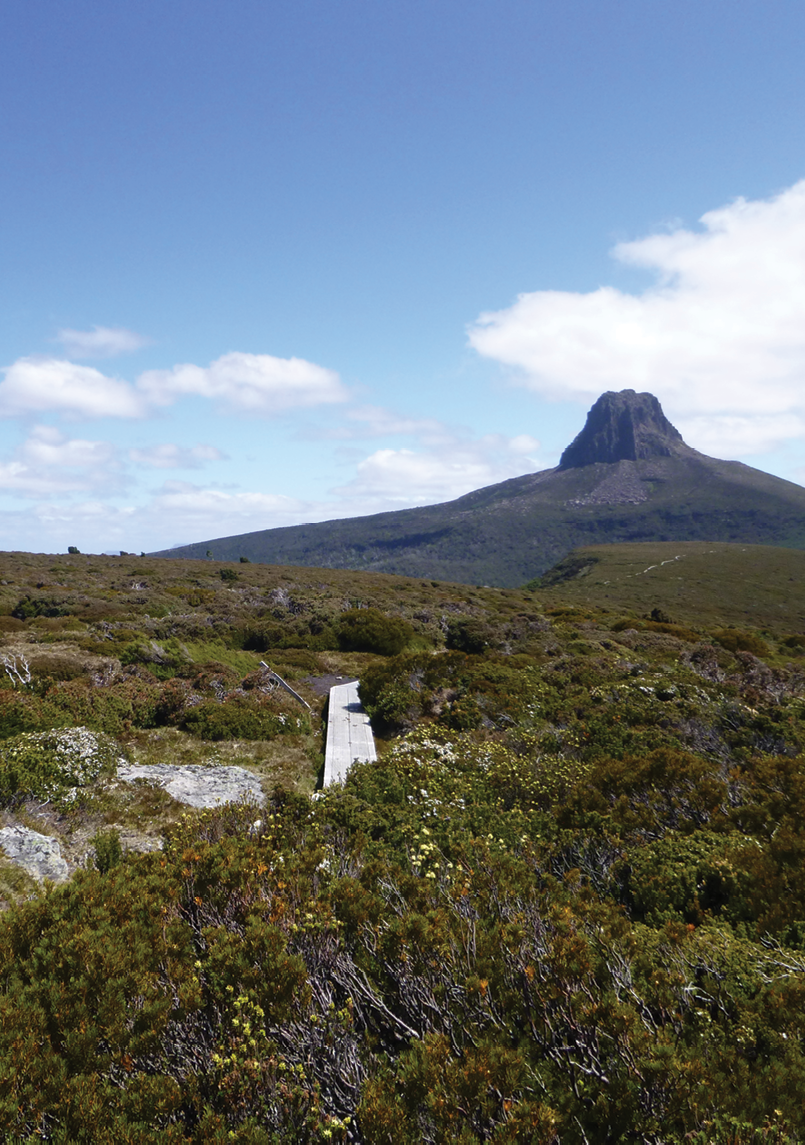


Barn Bluff from the Overland TrackStephen Lake
Tasmania's Overland Track (OLT) in Cradle Mountain Lake StClair National Park is perhaps Australia's most well known bushwalk. The OLT goes for 74 kilometres from Cradle Valley in the north to Cynthia Bay in the south, although most walkers stop at Narcissus Hut at 58 kilometres. Each year 8-9000 people walk the OLT, and nearby walks in the national park are very popular with day trippers and overnight walkers. Several aspects of the OLT are discussed in this article.

Overland Track
It's Good, But Could Be Better
Stephen Lake

18 | BWA June 2018
BackgroundAborigines have occupied the area for at least 10,000 years. In the 1820s, several surveyors explored what is now the Cradle Mountain—Lake St Clair National Park (CMNP). As the land was opened up, graziers and miners visited.
In 1912 Waldheim Chalet opened. Gustav Weindorfer led walks to nearby features as far south as Barn Bluff, and, of course, up Cradle. In 1922, 64,000 ha on what would later be the CMNP was gazetted as Scenic Reserve. In 1928, a Major Smith devised the term "overland track" to assist with seeking funding for the two reserves, Cradle Mountain and Lake St Clair. The Boards of the two reserves supported an overland track to link them. In 1935 funds were available to create a track that would be viable for guided tours and pack horses. When works were finished in 1937, the track was unofficially named the "Overland Track".
In 1936 the first Overland Track hut was built at Pelion, followed by Pine Valley Hut in 1942. A lot of the older huts on the track burned down over the years due to walkers leaving wood fires unattended. Modern huts are much better than those of the early days.
It is estimated that in the 1971-72 summer season, nearly 1500 walkers completed the OLT. Numbers are currently in the 8-9000 region. There's also thousands of tourists who do short walks at the Cradle and Lake St Clair ends. Visitors have a significant local economic impact. Numbers have increased, which means that there are more funds for maintenance and improvements, which may be a driver for more visitors.
The Tasmanian Wilderness World Heritage Area (WHA) covers about 1.38 million hectares. The WHA includes CMNP. In 1982 These and other areas were placed on the World Heritage list, international recognition of their natural and cultural heritage values. The WHA was expanded in size in 1989.
The OLT has a significant national and international profile. It has become an icon as one of the most popular overnight bushwalks in Australia, and is the best known of
Tasmania’s overnight bushwalks. Part of the appeal is that while the terrain and weather may be a challenge, the distances each day are short, the huts are mainly quite good, the track is easy to follow, and – above all – the scenery is spectacular.
Overland Track bookingsOLT walks must be booked for trips commencing between 1 October and 31 May. For this period there's a limit of 34 walkers per day, all southbound. The weather for 1 July to 30 September ensures that not many walk during winter.
The booking system has scope for improvement. I've suggested changes since mid-2016 and nothing has happened. The most obvious issue is that bookings open at 9am on 1 July each year. I asked the Tasmanian Parks and Wildlife Service (PWS) about this and was advised: “The current system of bookings opening on 1 July each year is linked to our Departmental financial reporting system and our business planning cycle. This system has existed since the booking system was introduced in 2005.” This seems to me to be a dusty answer. Every other holiday entity that I have dealt with can take payment in one financial year for use in the next financial year, so why can't PWS do this? PWS said that "improvements to the booking system are also under way." However, PWS declined to give details or a timeframe.
If bookings were able to be made prior to 1 July, then people who need or want to get a particular date can do so much earlier, easier and with more certainty. The 2017 bookings opened on a Saturday, so if there was a problem it was not possible to call PWS. Also, some days booked out very quickly. PWS said that the 2017 bookings were faster than usual. Bookings for 2018-19 open on a Sunday, so obtaining PWS advice on that day is impossible.
2017-18 booking patternStarting late on 1 July 2017 every ten days or so, about three times a month, I took screen shots for the peak OLT months of December 2017 and January 2018. When most days were booked out. Here are the figures.
BWA June 2018 | 19


Barn Bluff looking southStephen Lake
1 July
10 July
20 July
31 July
Dec available
47%
30%
21%
12%
January available
68%
51%
45%
37%
Total booked
43%
60%
67%
75%
By late on 1 July there were four OLT places left after 25 December. By 10 July there were just five OLT places left after 21 December. Bookings continued at a more or less steadt rate until November, with the booking rate easing slightly in September. It's similar
for January bookings, although not as pronounced. On 1 July, five days in the first two weeks of January had no or a small number of spaces. By 10 July there were five places available for 1-11 January inclusive. At 5.48pm on 1 July 2017, nearly nine hours after bookings opened, 43% of places for December and January had been booked. The demand is there for OLT bookings to be opened earlier.
Here are the figures by the month showing the number of places left for each month out of 1054 (34 a day for 31 days), that expressed as a percentage, and the total booked for both months combined.
Checked on
1 July
31 July
1 September
1 October
1 November
Available December
491
47%
128
12%
45
4%
15
1%
1
0%
Available January
720
68%
392
37%
187
18%
133
13%
69
7%
Total available
1211
57%
520
25%
232
11%
148
7%
70
3%
Booked
43%
75%
89%
93%
97%
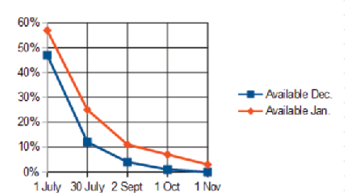
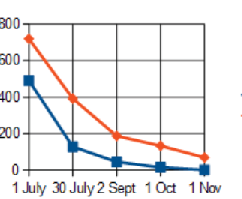
20 | BWA June 2018


Waterfall Valley Hut from the helipad
The cabins Waldheim cabins are within the national park, and are very conveniently located for an early start on the OLT. At $95 for a four person cabin for one night they are excellent value. The Waldheim booking pattern is similar to that of the OLT. By late on 1 July, three cabins were booked for 14 December, and 28 December had just one cabin available. Ten days later all the cabins for 28 December were booked. By the end of July, from 12 December there were 44 vacancies out of 168 possibles, 26% vacant, with just three vacancies after 23 December.
The cabin keys are available after 1.00pm, which does not assist walkers who come on the bus arriving at 11.20am. The reason for the 1.00pm key collection is due to the huts needing to be cleaned. With a checkout time of 10.00am and a few hours to clean the huts, the 1.00pm time makes sense. One option to make an earlier key collection viable is to have a checkout time of 9.30am, which seems reasonable for people going bushwalking. Also, have the booking form state when they party intends to leave. If bushwalkers leave at 8.00am then cleaning for that hut can be started first. Finally, ask
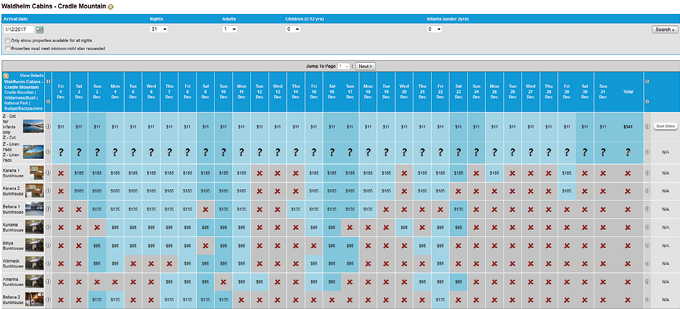
Waldheim cabins bookings for December on 31 JulyStephen Lake
BWA June 2018 | 21
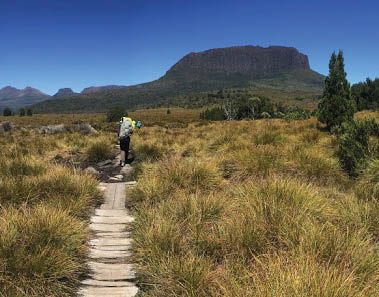

From Pine Forest Moor looking south past Mt Pelion
when a party will arrive. If the party is on the 11.20am bus, then their hut could be cleaned first.
I was quite shocked to see that the water in the huts is unfit for drinking. I saw no advice about this on the booking form or the website. I asked PWS for the science behind the warning about the water, and PWS did not reply.
I was advised that there was a bus shuttle to the huts. No. it goes to Ronny Creek. The driver could have stopped at the Waldheim turnoff, making my walk much shorter, but he kept going.
The website The PWS website is not as good as it might be. Like so many other websites it has fallen victim to fashion and has small typefaces with low contrast. I'm probably a bit more demanding than most people as I have worked in graphics for decades and have written about this.
The PWS information sheets are also quite hard to read. For reasons that are unclear, PWS have abandoned accepted graphics rules and use faded typefaces. Information that works well when printed may not work very well on a screen. I sought advice from PWS about this but there was no reply.
In mid-2017 PWS advised that the website was being reviewed. There has been no change since then. In April 2018 PWS advised that "A new look website is under development" but again declined to give details or a timeframe.

Non-potable water at WaldheimStephen Lake
22 | BWA June 2018
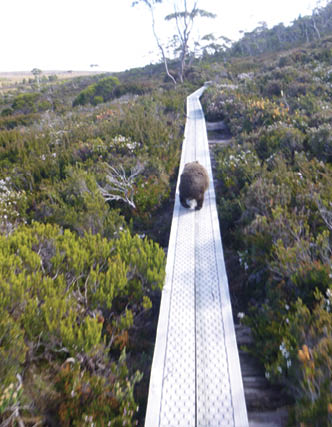

Wombat on a board track
Rough track
OLT bookingThe booking page is marginal. It took me a little while to determine how the bookings status works. It does not assist that the typeface and background are similar shades, and that it's hard to see which availability numbers belong to which dates. The thicker line under the dates seems to rule off the dates, but in fact the dates have their available spaces underneath. Odd. There is no clear explanation about the numbers. The figures for 31 December did not show on a number of computers, seems to be a coding bug.
Booking Waldheim cabins took a bit longer than I would like, a slightly obscure process. However, once done the advice from the booking agency was swift and quite clear.
Waldheim booking One point that I missed was that when selecting a time period, say four days, this means that the screen will show four days from the start date.
Summary It seems to me that PWS can do better. The website is hard to use, bookings should open earlier, and information should be clearer. Waldheim keys should be available earlier.
The trackI found the variety of tracks fascinating.
Basic track, earth, no treatment.
Basic track, rocks. This varies from broken rocks on a steep ascent, crazy paving, a very rocky track, and steps that range from quite big to narrow and potentially slippery in the wet.
Probably the first treatment, split timber, 40-60 years old, slowly rotting and being replaced.
Modern default boardwalk, about 1200 mm wide, laid across the length of the track. Some of these are curved and quite pretty.
Modern lengthwise boards, in a variety of sizes and formats. The most common is two boards 240 mm wide beside each other. In some places there is only one board, which is a bit hairy in the wet and wind, with a potential to fall off. Some lengthwise boards are 180 mm wide, laid as a pair. Where lengthwise boards come to a creek, invariably they change to 1200 mm wide across the creek. One creek had a single board 240 mm wide. Near here the wind grabbed me and I fell off the 240 mm track, missing having concussion by a very small margin. In my view PWS has a duty of care to have safe tracks, and at this place that duty was not met.
BWA June 2018 | 23
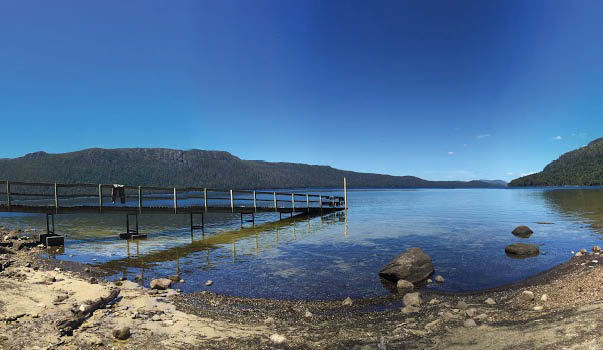

Echo Point pier and Lake St ClairMatt McClelland
The top may be bare, chicken wire, or bitumen.
Steps range from fairly shallow to quite deep, The latter would be easier with a walking pole. Some steep rocky steps are probably tricky in the wet.
It was nice to see the new track next to a slowly recovering old track. Forty or more years ago the OLT was very muddy, now thankfully gone. Those with long memories will be happy to consign Pigsty Ponds and other places to history. The new boardwalk to Mount Oakleigh is most welcome. Other places like parts of the South Coast Track have been similarly treated, to the advantage of the environment and walkers.
However, the downside is that if it's too easy then more people will be attracted, some of whom may be ill-equipped, unfit, lack adequate experience, or lack adequate gear.
Camping platformsThere are focal points on the OLT and elsewhere, notably at huts, where platforms have been installed. Unfortunately the platforms lack two subtle aspects that would improve them. The platforms are built flat, which is not to my liking. A few years ago when I camped on a platform at Windy Ridge I became quite wet, with a lot of water flowing under the tent. A better design would
be to have the boards slightly sloping so that water runs off the long edge of the boards. In the opposite direction, if the boards were slightly curved then water would run away from the tent. The angles do not have to be much, just a few degrees. Sadly, the platforms will last for ages. Another solution is to cut shallow grooves in the boards to make water stop on its journey to the tent floor.
Windy Ridge HutThis hut was purpose built about 10 years ago, and does not meet contemporary standards, never has, and, without modifications, never will. Basic designs that have been know for a century or more were ignored. There is no effective airlock on the main door; a futile attempt has been made to combine an air lock with a drying room. This space has mesh about 100 mm high around most of the walls.
There is no air lock on the common room door, so warm air is easily lost to the outside. The common room heater is a few metres up a wall, nearly totally ineffective. The common room ceiling is a massive five metres or so high, quite foolish. The bunk rooms are on a different level to the common room, with the drafty air lock aka drying room between. The lower bunks are on the floor, next to cold air, which sinks. I'm advised that in winter
24 | BWA June 2018
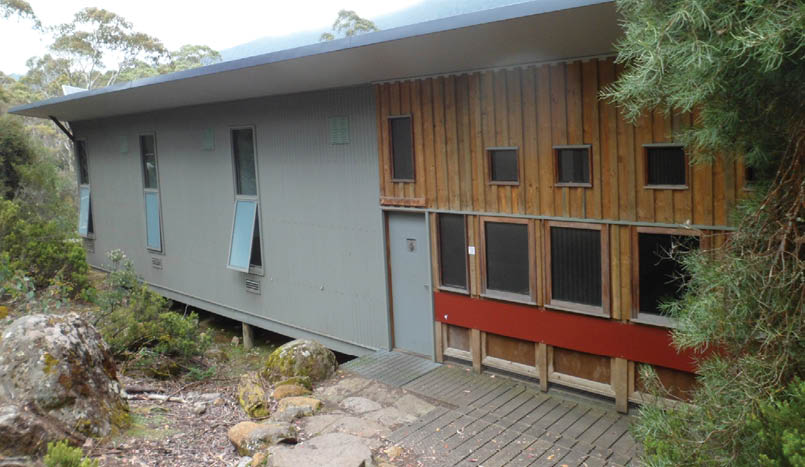

the bunkroom celings drip, making only the cold lower bunks viable. The bunk rooms are gloomy. It would have been easy to build a raised path between the hut and the toilet. Instead, users must go down steps, along a short series of paths, then up steps.
The hut quickly obtained a new name – Windy Fridge.
A far better design is for a hut on one level, with contiguous entry, common and bunk rooms. Air locks should be on all external doors. Ceiling at about 2700-3300 mm work. A heater at floor level is best. Have a separate drying room. Older OLT huts have superior designs, and are much warmer. Windemere was about 12ºC on a cool day. Once people came in the temperature rose to 15ºC. When people were cooking it was very nice, 20ºC. Windemere has a large porch, no air lock, contiguous common room and bunk room, and ceilings up to about 3 metres high.
Over several years a number of PWS staff have been asked in person about Windy Ridge. The above shortcomings were cited, and all staff declined to respond, to defend the design. A few just rolled their eyes with an expression that spoke volumes. When asked about Three Capes the PWS staff were very descriptive, advising that while several things could have been done better, overall
Three Capes has been a huge success. No such comments were made about Windy Ridge.
I asked PWS why Windy Ridge was so badly designed. I asked about having an airlock installed on the common room door, and having the drafty main entry "air lock“ made more airtight. A satisfactory answer was not received. The matter is being investigated by the Auditor General.
Post tripPWS sent a survey to me a few weeks after ending the OLT. I found the survey somewhat long with questions that were hard to answer or seemed to me to have limited relevance. For example, one question asked if the OLT was easier or harder than expected. The answer surely reflects the level of experience of the walker. The survey had a lot of questions, and in the end I gave up. It was taking too long to complete. A survey at Cynthia Bay may lead to more respones. It would be much faster and easier to do the survey on paper. While this may get more responses, PWS resources would be needed to key the results. A scanner that recognises text may work.
Tasmania PWS were sent a late draft of this article and declined to comment in detail on any of the matters raised.
Windy Ridge Hut front door, no airlockStephen Lake
BWA June 2018 | 25